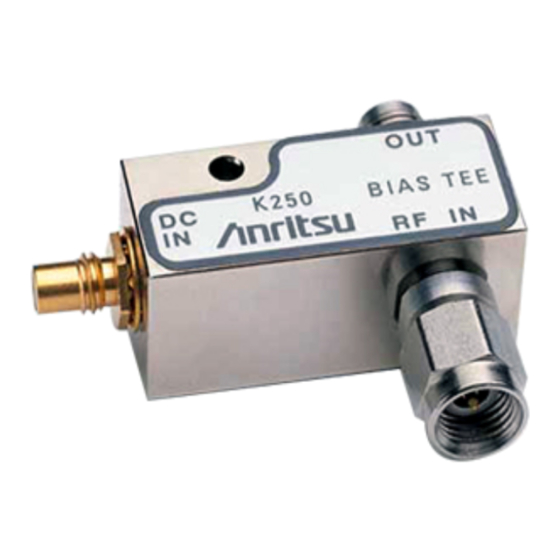
Advertisement
Table of Contents
1.
INTRODUCTION
This manual describes the Model K250 and V250
Bias Tee (Figure 1). It provides specifications and a
list of precautions the user should observe when us-
ing the bias tees.
2.
DESCRIPTION
The precision K250 and V250 Bias Tees were de-
signed for applications where both dc and RF signals
must be applied to a device under test. They are par-
ticularly suited for active device measurements. DC
voltages of up to 30 volts at 0.5 amperes may be ap-
plied to test devices with negligible effect on RF per-
formance. Low RF throughline loss (dB) and low re-
turn loss ensure negligible effect on measurements
up to 60 GHz. An RF input dc block isolates the in-
put port from the applied bias voltage.
3.
SPECIFICATIONS
Table 2 provides performance specifications.
490 JARVIS DRIVE l MORGAN HILL, CA 95037-2809
OPERATION AND MAINTENANCE
MANUAL FOR BIAS TEES
Figure 1. Model K250 Bias Tee
4.
PRECAUTIONS
ANRI TS U K250 an d V250 Bias Te e s are
high-quality, precision laboratory devices and
should receive the same care and respect afforded
other such components. Complying with the follow-
ing precautionary notes will guarantee longer com-
ponent life and less equipment downtime due to con-
nector failure. Also, such compliance will ensure
that RF component failures are not due to misuse or
abuse—two failure modes not covered under the
ANRITSU warranty.
a. Beware of Destructive Pin Depth on Mating
Connectors. Measure the pin depth of the con-
nector that mates with the RF component, before
mating. Use an ANRITSU Pin Depth Gauge
(Figure 2, Table 1) or equivalent. Based on RF
components returned for repair, destructive pin
depth on mating connectors is the major cause of
failure in the field. When an RF component con-
nector is mated with a connector having a de-
structive pin depth, damage will likely occur to
the RF component connector. (A destructive pin
COPYRIGHT 1992 ANRITSU COMPANY
P/N: 10100-00025
REVISION: D
PRINTED: MARCH 2000
Advertisement
Table of Contents

Summary of Contents for Anritsu K250
- Page 1 INTRODUCTION PRECAUTIONS This manual describes the Model K250 and V250 ANRI TS U K250 an d V250 Bias Te e s are Bias Tee (Figure 1). It provides specifications and a high-quality, precision laboratory devices and list of precautions the user should observe when us- should receive the same care and respect afforded ing the bias tees.
- Page 2 01-162 ANRITSU recommends that no maintenance other than cleaning be attempted by the customer. The bias tee should be returned to ANRITSU for repair depth has a center pin that is too long in respect and/or service when needed. to the connector’s reference plane.)
- Page 3 Table 2. Performance Specifications, 1 of 2 Specification K250 V250 Frequency Range 0.1 to 40 GHz 0.1 to 60 GHz Insertion Loss 1.2 dB maximum 2.2 dB maximum 13 dB minimum to 20 GHz 15 dB minimum to 20 GHz...
- Page 4 1.15 NOM 0.5 NOM 0.106 THRU 0.310 NOM 0.525 NOM K or V 0.100 NOM FEMALE BIAS TEE K250 0.5 NOM 0.25 NOM RF IN K or V MALE 0.25 NOM Outline Drawing (K and V Models; Dimensions in Inches)
















Need help?
Do you have a question about the K250 and is the answer not in the manual?
Questions and answers